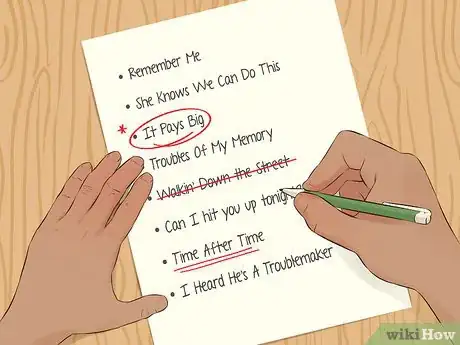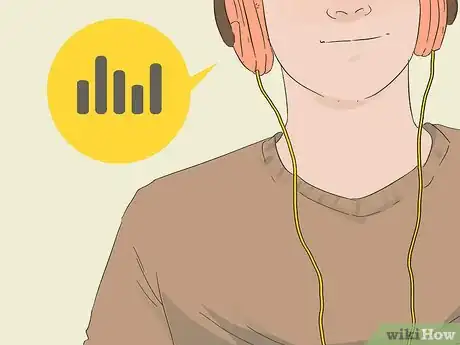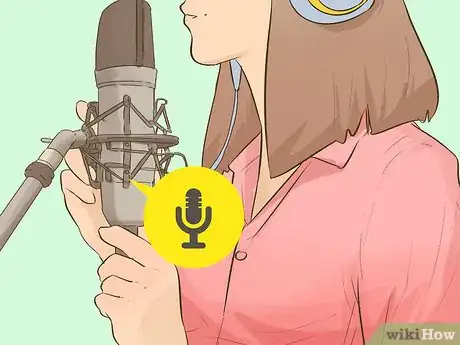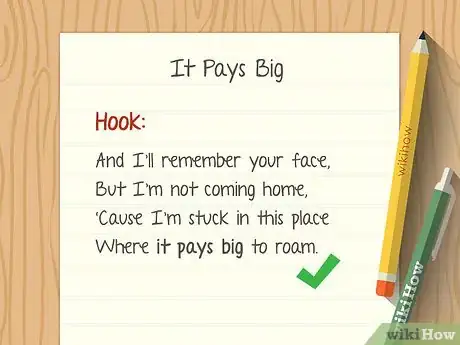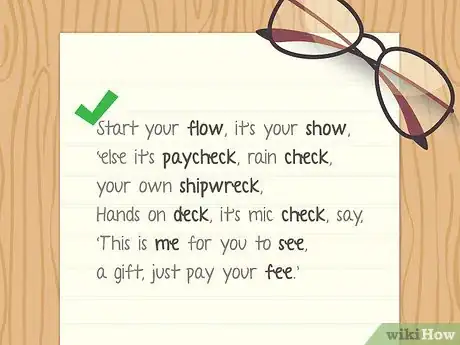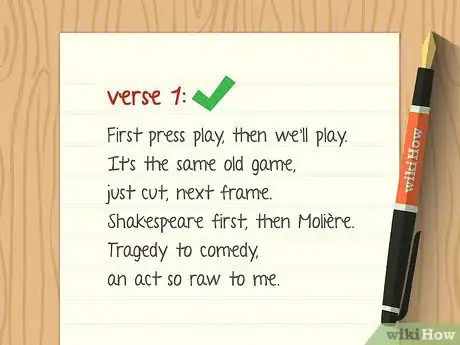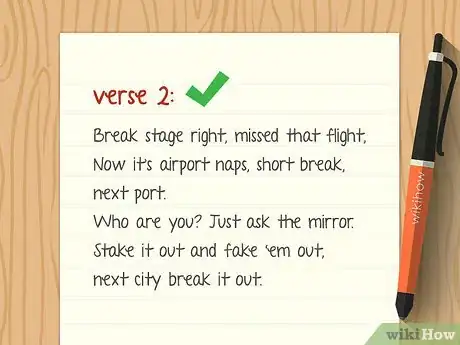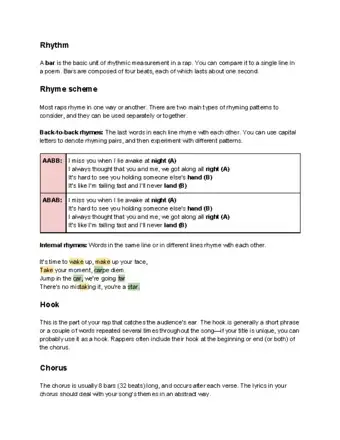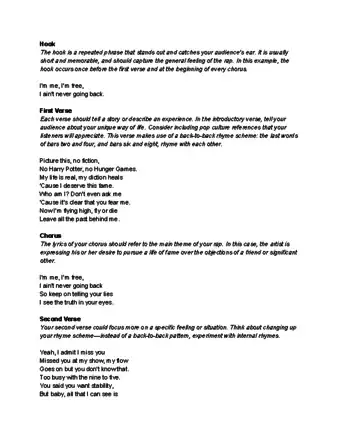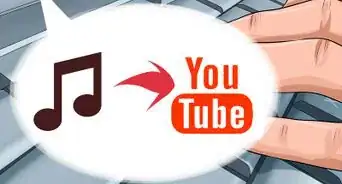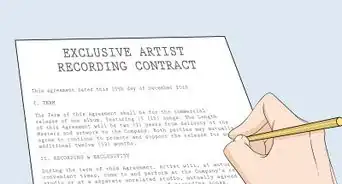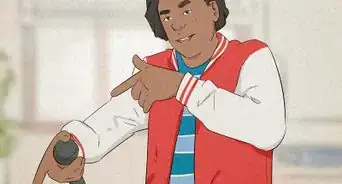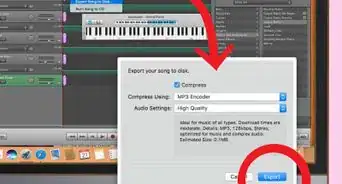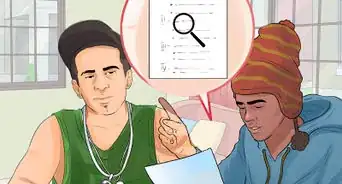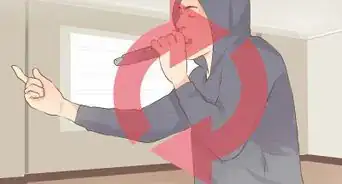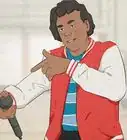This article was co-authored by Tanisha Hall. Tanisha Hall is a Vocal Coach and the Founder and Executive Director of White Hall Arts Academy, Inc. an organization based in Los Angeles, California that offers a multi-level curriculum focused on fundamental skills, technique, composition, theory, artistry, and performance at a conservatory level. Ms. Hall's current and previous students include Galimatias, Sanai Victoria, Ant Clemons, and Paloma Ford. She earned a BA in Music from the Berklee College of Music in 1998 and was a recipient of the Music Business Management Achievement Award.
There are 14 references cited in this article, which can be found at the bottom of the page.
wikiHow marks an article as reader-approved once it receives enough positive feedback. This article received 15 testimonials and 95% of readers who voted found it helpful, earning it our reader-approved status.
This article has been viewed 2,637,641 times.
We all know one rap that gives us the chills, but what exactly sets it apart from others? Lyrics! While it can be daunting to start from scratch, we’ll teach you everything you need to know to draft your own rap. From brainstorming to writing the bridge, here’s how to create a personal rap that makes your audience feel something.
Things You Should Know
- Use your personal experiences to inspire your lyrics, and freestyle over an instrumental beat to help you determine the vibe of your song.
- Make a list of potential song titles and use them to come up with the hook, or catchiest part of the song.
- Experiment with different lyrical rhythms to write the chorus—rap each word on the beat if you have 32 words, or rap 14 of them on the beat if you have 15 words.
- When writing your verses, think of them as a story—the first verse is the introduction, the second is the half-way mark, and the third is the ending.
Steps
Brainstorming Your Lyrics
-
1Use your personal experiences to inspire your lyrics. While it’s easy to follow other rappers and imitate their stories, write about your own experiences to stand out from the crowd. Talk about your childhood, struggles, and dreams, and include specific details in your writing. You might talk about the street you grew up on, your favorite brands, or how you feel about situations and events.[1]
- When you tell your own stories, your audience might find something they can relate to and connect with you on a deeper level.
- If you’re stuck, take inspiration from the world around you. Read books, watch movies, talk to strangers… do anything to step out of your comfort zone and expand your horizons!
-
2Create a running list of possible song titles. While this might sound counterintuitive, start with your song title to help you narrow down your ideas. Listen for catchy phrases in movies, books, advertisements, and real life, then alter them to fit your vision as a songwriter.[2]
- Write your list down on your phone or notepad so you don’t forget anything.
Advertisement -
3Listen to a few different instrumental beats. To figure out the vibe of your song, take some of your potential song titles and rap them over different beats. Playing around with beats allows you to hear what sounds might fit the best with your lyrics.[3]
- You can collaborate with a producer to create a unique track or look up a free beat on Soundcloud or Youtube.
- If you enjoy a specific rapper’s sound, type in their name before looking up a beat online. For example, you might search for “Bryson Tiller type beat” if you’re looking for an RnB track or “Jack Harlow type beat” if you want something more breezy and trap-influenced.
-
4Record yourself freestyling on your phone or computer. Once you find a beat you like, improvise a few lines to tap into your creativity. Say whatever comes to mind, and hum or speak gibberish to fill in any gaps in your flow. Listen to your recording and jot down anything that sounds good—you can use it to write some parts of the song.[4]
- For example, you can write down a mumble like “In a hmm hmm state of mind, gotta gotta get the grind.” Then, you can go back and change the words: “In a London state of mind, you can catch me on the grind.”
Composing Your Chorus
-
1Use your potential titles to come up with a hook. The hook is the catchy part of the song that sticks in your head. If your title is memorable, place it at the beginning or end of the chorus (or both), and repeat it throughout the song as much as possible.[5]
- The hook to Snoop Dogg’s song “Drop It Like It’s Hot,” for example, is “Drop it like it’s hot,” which is repeated numerous times throughout the song.[6]
- You don’t necessarily have to use your title to come up with a hook—just play around with different lyrical phrases you’ve come up with that you think might work well.
-
2Experiment with different lyrical rhythms. Most raps are 80 beats per minute (BPM), meaning each beat lasts a little under a second. There are also usually 8 bars in the chorus of a rap with the beat on the quarter note, meaning the chorus will have 32 beats in it. To determine your lyrical rhythm, count how many words you have in your lyric:[7]
- If you have 32 words (or a smaller number of words with 32 syllables), rap each word or syllable on the beat.
- If you have 15 words, rap 14 of them on the beat, with 2 of them lasting 4 beats total.
- Beginner tip: use a metronome or a metronome app to keep track of the beat. After you’ve been writing for a while, you can probably internalize the beat without any tools.[8]
-
3Try out various rhyming schemes. If you’re a beginner, rhyme your lines to help you get through the writing process. Many raps rhyme the last word in back-to-back lines or every other line, but you can experiment with rhymes that happen in the middle of lines or are multisyllabic.[9]
- If you’re struggling to come up with the next line in your rap, use a rhyming dictionary to help you overcome writer’s block.[10]
- If you rhyme all the time, it can limit your creativity and interfere with your flow—once you get comfortable writing raps, challenge yourself to write a song that doesn’t include any rhymes.
Finalizing Your Verses
-
1Write your first verse. Rap verses usually have 16 bars, so they’re twice as long as the chorus. The lyrics in the chorus are generally meant to deal with your song’s themes in a vague way, while the lyrics in the verses are meant to provide more specific examples. When you approach the verses, think of them as telling a story—the first verse is the opening line that hooks your attention.[11]
- In Jay-Z’s song “99 Problems,” for example, the first verse describes Jay-Z’s portrayal in the media, and his issues with the radio, rap magazines, and advertisers.[12]
- Experiment with the rhythm and rhyme scheme of your verse in the same way that you did for your chorus.
-
2Base your second and third verses on the first. After you write your first verse, follow your natural instinct to come up with the next two. The second verse serves as the middle of your story, while the third acts as the conclusion.[13]
- In the second verse of “It Was a Good Day,” for example, Ice Cube raps about not being bothered by his enemies after rapping about his mom making him breakfast in the first verse.[14]
- Generally, rappers use the same rhythm and rhyme scheme in their second and third verses as in their first, but don’t be afraid to change it up to add something your audience won’t expect.
-
3Add your bridge. The bridge is like a chorus in that it’s meant to be vague—but it also adds something new to your song lyrically, musically, or both. If you came up with other ideas for hooks in the brainstorming phase, you can use one of them to build your bridge’s lyrics. Then, try playing around with different rhythms, rhyme schemes, and vocal pitches to see what sounds best.[15]
- In the song “Heartless,” for example, Kanye West raps his bridge in a different rhythm and in a higher vocal pitch than the rest of the song.[16]
Community Q&A
-
QuestionWhat's the best environment to write a song?
 wikiHow Staff EditorThis answer was written by one of our trained team of researchers who validated it for accuracy and comprehensiveness.
wikiHow Staff EditorThis answer was written by one of our trained team of researchers who validated it for accuracy and comprehensiveness.
Staff Answer wikiHow Staff EditorStaff AnswerSome people enjoy writing in nature, while others prefer writing in their bedroom. Try to switch up your environment to see where you feel the most comfortable. You can try writing in your local coffee shop, park, or even in your car!
wikiHow Staff EditorStaff AnswerSome people enjoy writing in nature, while others prefer writing in their bedroom. Try to switch up your environment to see where you feel the most comfortable. You can try writing in your local coffee shop, park, or even in your car! -
QuestionHow do I save my raps?
 wikiHow Staff EditorThis answer was written by one of our trained team of researchers who validated it for accuracy and comprehensiveness.
wikiHow Staff EditorThis answer was written by one of our trained team of researchers who validated it for accuracy and comprehensiveness.
Staff Answer wikiHow Staff EditorStaff AnswerYou can save your raps on your phone, computer, or a platform like Soundtrap.
wikiHow Staff EditorStaff AnswerYou can save your raps on your phone, computer, or a platform like Soundtrap. -
QuestionIs it necessary to put rhyming words in your rap?
 wikiHow Staff EditorThis answer was written by one of our trained team of researchers who validated it for accuracy and comprehensiveness.
wikiHow Staff EditorThis answer was written by one of our trained team of researchers who validated it for accuracy and comprehensiveness.
Staff Answer wikiHow Staff EditorStaff AnswerNo. The second verse in Little Brother's "Whatever You Say" is a great example of a solid line that doesn't rhyme. If you're a beginner, rhyming can help you follow the structure of a song, but it can limit your creativity overtime. Once you get comfortable with the writing process, challenge yourself and write a song without any rhyming words!
wikiHow Staff EditorStaff AnswerNo. The second verse in Little Brother's "Whatever You Say" is a great example of a solid line that doesn't rhyme. If you're a beginner, rhyming can help you follow the structure of a song, but it can limit your creativity overtime. Once you get comfortable with the writing process, challenge yourself and write a song without any rhyming words!
References
- ↑ https://dailybruin.com/2020/10/09/life-and-hip-hop-artists-draw-inspiration-from-lived-experiences-and-hometowns
- ↑ https://mysongcoach.com/write-a-song-in-ten-steps/
- ↑ https://www.rappad.co/blog/learn-how-to-write-great-rap-lyrics
- ↑ https://www.connollymusic.com/stringovation/how-to-build-your-improvisation-skills
- ↑ https://www.bmi.com/news/entry/4_dos_and_donts_when_writing_songs
- ↑ https://genius.com/Snoop-dogg-drop-it-like-its-hot-lyrics
- ↑ http://colemizestudios.com/how-to-rap-structuring-lyrics/
- ↑ https://youtu.be/dDRfWymngN4?t=53
- ↑ https://www.rappad.co/blog/learn-how-to-write-great-rap-lyrics
- ↑ https://www.rappad.co/blog/learn-how-to-write-great-rap-lyrics
- ↑ https://www.kdd.org/kdd2016/papers/files/adf0399-malmiA.pdf
- ↑ https://genius.com/Jay-z-99-problems-lyrics
- ↑ https://www.kdd.org/kdd2016/papers/files/adf0399-malmiA.pdf
- ↑ https://genius.com/Ice-cube-it-was-a-good-day-lyrics
- ↑ https://www.bmi.com/news/entry/to_bridge_or_not_to_bridge_and_other_songwriting_questions1
- ↑ https://genius.com/Kanye-west-heartless-lyrics
About This Article
To write rap lyrics, try using personal experiences you've had as the inspiration for your lyrics, like by thinking about the street you grew up in or the city where you lived. Additionally, try listening to several beat tracks for inspiration. Once you've got a few ideas, record yourself improvising some lyrics on your phone so you can hear how they sound. You should also experiment with the rhyme structure, such as by trying to make one line after the other rhyme, or by testing out rhyming lyrics in the middle of a line. For tips on how to create a hook and how to write a chorus, read on!

